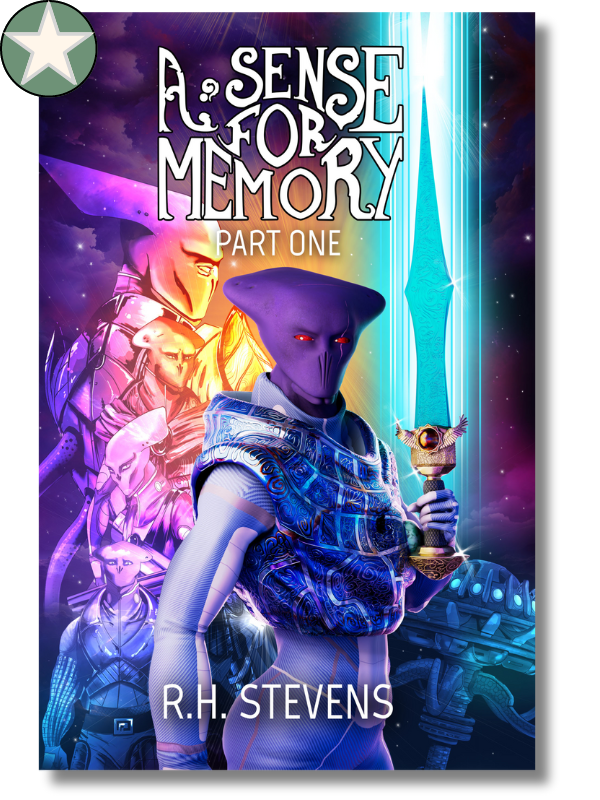
A Sense for Memory (Part One)
by R.H. Stevens
Genre: Science Fiction / Illustrated
ISBN: 9780645922424
Print Length: 371 pages
Reviewed by Kathy L. Brown
An unforgettable immersion into smart science fiction at its very best
Two stories compose the book A Sense for Memory, which treats the reader to a pair of engaging protagonists, each showcased in her own science fiction novella. This volume is the first in the Z-verse series.
The opening story features Commander Qwatajawa, the head cop in a rustic beach town on Cualli Island. Cualli and its planet are part of the Rej-jir race’s planetary system. This small island is one of many in an archipelago that also includes an island-isolated maximum security prison. But the prison isn’t her concern, at least at the story’s start. An island visitor has disappeared, and CCTV indicated he was attacked and kidnapped or even murdered off screen.
Owatajawa’s investigation soon reveals that the missing Zurxok (a neighboring system’s native race) male was a courier, tasked with transporting a valuable and dangerous artifact. It, too, is missing.
Owatajawa has the firm confidence of her superior but only begrudging obedience from most of her junior officers. Thus, the Rej-jir cop feels her best option to solve the case, rescue the Zurxok courier, and recover the artifact is to consult a trusted old friend with expertise in dangerous magical items: the Zurxok illusionist Xa-Kol. Childhood friends, they trust each other implicitly.
Xa-Kol is the protagonist of A Sense for Memory’s second novella. The story takes us back to her youthful illusionist training days. On the verge of washing out of the academy for excessive interpersonal conflicts with other students, she travels to a new illusionist center on an isolated, recently terraformed planet. There she will study with a famous old master. Or so she thinks. Xa-Kol finds herself toting crates and laying brick by hand (with machinery right there!), all in the service of building character. Or something.
Resentful at first, her rebellious nature kicks up quite a bit of conflict at first. But she does learn enough to develop some skills with the master. She explores the planet with a new Rej-Jir friend and is especially impressed with the remaining pockets of the old world, species and ecosystems hidden in rocky enclaves.
Meanwhile, at higher political levels, the terraforming is controversial, and that conflict spills into Xa-Kol’s world, threatening both her friend and the peaceful illusionist center she has built with her master. Facing the threat means facing some not-so-pleasant aspects of herself.
Both stories use a close, third-person point of view. I really enjoyed experiencing these character’s thoughts and feelings. Qwatajawa and Xa-Kol, as well as the other surrounding characters, are distinct individuals. Their personalities are expressed well through their actions, attitudes, and speak patterns.
The stories’ milieus are revealed gradually, gracefully, through the narrative. The reader has just enough information to easily follow the action of each scene, leaving them eager to learn more about the characters and their problems. For example, when the courier, Ushen-Takaan, picks up the mysterious parcel, he reveals much with this bit of interior processing, “The antiquarian from whom Ushen-Takaan picked up the parcel was a Rej-Jir so old her skin color had faded to lilac, eyes milky from the weight of centuries. Somehow, she had struck him as being beautiful. It was uncommon to see the physical evidence of old age when the technology for approximating endless youth was so accessible.”
Immersive details yield a great narrative experience for the reader. The book’s worldbuilding is impressive, exquisitely detailed in every aspect from geography to biology to cultural norms. The individuals and societies portrayed would be called “alien” by humans, but we’re not there. While the conflicts are relatable to planet Earth, there are no Sol system explorers to weigh in with opinions. (That is left to us, the readers.)
The book features maps, charts, and illustrations, which reinforce our mental picture of the characters as well as enhance the narrative.
A Sense for Memory raises important political and ecofiction themes: How does society balance individual rights with society’s needs? What is cruel punishment? What are sentient beings’ responsibilities to the land and “lower” animal and plant life? How does commerce and industrial expansion balance with the interrelated systems that support all life? What means are justified and what sacrifices are acceptable to institute change?
These stories are a pleasure to experience. Fans of character-driven science fiction will love getting to know Qwatajawa, Xa-Kol, and their respective worlds. I look forward to reading more stories in this intriguing setting.
Thank you for reading Kathy L. Brown’s book review of A Sense for Memory by R.H. Stevens! If you liked what you read, please spend some more time with us at the links below.


0 comments on “STARRED Book Review: A Sense for Memory (Part One)”